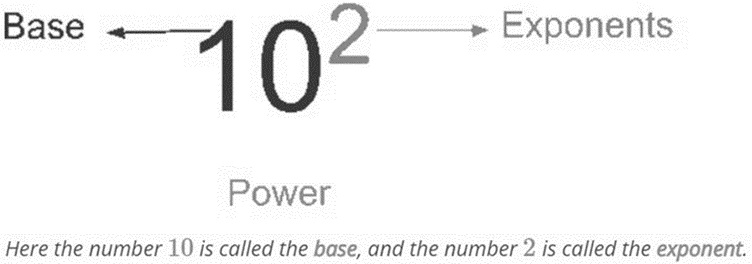1. Powers
- Books Name
- class 8 th Mathematics Book
- Publication
- ReginaTagebücher
- Course
- CBSE Class 8
- Subject
- Mathmatics
Exponents and Powers
Powers
Powers and exponents
1. Power: The power is the product of multiplying a number by itself. It shows how many times the base is multiplied by itself.
2. Base: The base number tells what number is being multiplied.
3. Exponent: The exponent, a small number written above and to the right of the base number, tells how many times the base number is being multiplied.

Law of exponents
1. Product law
According to the product law, the exponents can be added when multiplying two powers with the same base.
an×am= a n+m ,where a≠0 and a, m, n are integers.
2. Quotient law
The quotient law states that we can divide two powers with the same base by subtracting the exponents.
an:am = an/am = an-m
,n>m,a≠0 where, a, m, n are integers.
3. Power law
The power law states that when a number is raised to a power of another power, we need to multiply the powers or exponents.
(an)m=anxm, where a≠0 and a, m, n are integers.
Powers with Negative Exponent
A number with negative exponent is equal to the reciprocal of the number with positive exponent.
That is, a-n=1/a n, here n is an integer.
If the negative number (−1) raised to the negative odd power (−1odd power), then the resultant value is negative (−1).
If the negative number (−1) raised to the negative even power (−1even power), then the resultant value is positive (1).
Rules for the exponent 1 and 0
Exponent with 1: For any number when it is rises to the power of 'one'(1), it equals itself: a1=a. where a≠0
Exponent with zero: For any number when it is raised to the power of 0 it is always equals to the number 1: a0=1.
2. Use of Exponents to Express Small Numbers in Standard Form
- Books Name
- class 8 th Mathematics Book
- Publication
- ReginaTagebücher
- Course
- CBSE Class 8
- Subject
- Mathmatics
Use of Exponents to Express Small Numbers in Standard Form
The standard form of a number
When switching from a number to a normal notation (standard form) or vice versa, move the period to the right or left in the number and multiply it by 10 the appropriate degree.
If the number is less than 1, then writes it in the normal form 10 with a negative exponent.
If the given number is less than one, to convert that number to standard form, transfer the decimal to the right side of the number.
Consider a number 17845600; we can rewrite this number in standard form.
That is 17845600=1.78456×107.
Small number to standard form
Step 1: Observe whether the number is between 1 and 10 or it is less than 1.
Step 2: If the number is between 1 and 10, then write it as the product of the number itself and 100.
Step 3: If the number is between 0 and 1, then move the decimal point to the right side so that there is just one digit on the left side of the decimal point.
Write the given number as the product of the number obtained and 10-n, here n denotes the number of places the decimal point has been moved to the right side.
Standard form to usual form
1. Expand the given 10n and multiply it by the given number.
2. Then the result will be in the usual form.
Write the following numbers in usual form.
i) 1.0867×104
The given number is 1.0867×104.
Expand the 104 and multiply it by the given number.
1.0867×104=1.0867×10000=10867
Therefore, the usual form of 1.0867×104 is 10867.

 ReginaTagebücher
ReginaTagebücher
